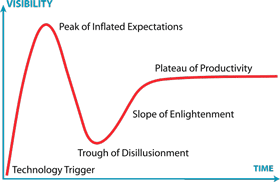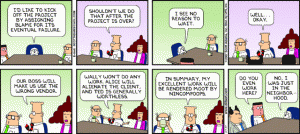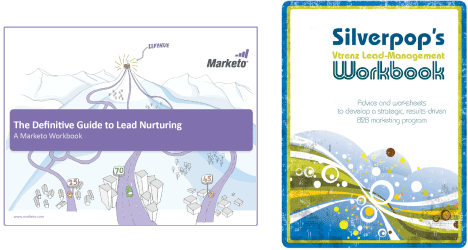LeadSloth Marketing Automation Blog – Survey Results
About two weeks ago I posted a survey that asked the LeadSloth readers what they wanted to read about. As it goes with surveys, it took some effort to get people to fill it out. But this week it reached critical mass, so I was able to draw some interesting conclusions.
The Most Requested Topics
The top 6 topics mentioned in the survey were:
Metrics & ROI
Marketing Automation Best Practices
Lead Nurturing / Drip campaigns
Landing Pages & Forms
Social Media
It is interesting to see that ROI and Best Practices score so high. I was surprised to see Landing pages & forms: important, but not very exciting. And the last topic “Social Media” confirmed my gut feeling that Social Media is hotter than Inbound Marketing and Search Marketing (which were hardly mentioned by the respondents).
There were also some runner-up topics:
Data Quality & Data Management (boring but essential)
Multi-channel Campaigns (not for everyone)
Content Marketing (the latest trend)
The Favorite Types of Posts
The first question was about the topics, and this one is about the way it is delivered. These were the preferred types of articles:
Thought leader interviews
Practical how-to articles
Opinion pieces
Advanced topics
I was surprised to see that the large majority of respondents mentioned Thought Leader Interviews: I clearly need to do more of those. Then both practical but advanced posts and opinion pieces were highly valued: clearly people enjoyed some of the recent posts that had a lot of discussion, like the “7 reasons why marketing automation projects fail” post.
Other Interesting Comments
In the text boxes people gave lots of useful suggestions, like these:
Choose your own “purple cow”
Avoid vendor bias
Talk about the best mix of lead gen approaches (also based on the economy)
Explain how to make a business case for Marketing Automation
And luckily one person responded to my request for jokes. Here we go: “A plane was flying to Houston. A blonde girl stood up, walked up to First Class and sat down. They asked her to move back to coach and she refused. They asked for help and she still refused. Finally, they asked the pilot to speak to her. He whispered something into her ear, she stood up and walked back to Coach. Asked about the remarkable thing he said, he told them “I simply told her First Class was not going to Houston.” ”
Conclusion
Based on these results, I will try to keep posting once or twice a week, but with more focus more on Thought Leader interviews and on vendor-neutral articles. I will focus on Marketing Automation and Social media, with an emphasis on mid-size to large marketing teams. ROI and best practices will be the main topics, but always with a practical voice. And maybe I will throw in the occasional joke ;-)
Let me know any additional feedback!
About two weeks ago I posted a survey that asked the LeadSloth readers what they wanted to read about. As it goes with surveys, it took some effort to get people to fill it out. But this week it reached critical mass, so I was able to draw some interesting conclusions.
The Most Requested Topics
The top 6 topics mentioned in the survey were:
- Metrics & ROI
- Marketing Automation Best Practices
- Lead Nurturing / Drip campaigns
- Landing Pages & Forms
- Social Media
It is interesting to see that ROI and Best Practices score so high. I was surprised to see Landing pages & forms: important, but not very exciting. And the last topic “Social Media” confirmed my gut feeling that Social Media is hotter than Inbound Marketing and Search Marketing (which were hardly mentioned by the respondents).
There were also some runner-up topics:
- Data Quality & Data Management (boring but essential)
- Multi-channel Campaigns (not for everyone)
- Content Marketing (the latest trend)
The Favorite Types of Posts
The first question was about the topics, and this one is about the way it is delivered. These were the preferred types of articles:
- Thought leader interviews
- Practical how-to articles
- Opinion pieces
- Advanced topics
I was surprised to see that the large majority of respondents mentioned Thought Leader Interviews: I clearly need to do more of those. Then both practical but advanced posts and opinion pieces were highly valued: clearly people enjoyed some of the recent posts that had a lot of discussion, like the “7 reasons why marketing automation projects fail” post.
Other Interesting Comments
In the text boxes people gave lots of useful suggestions, like these:
- Choose your own “purple cow”
- Avoid vendor bias
- Talk about the best mix of lead gen approaches (also based on the economy)
- Explain how to make a business case for Marketing Automation
And luckily one person responded to my request for jokes. Here we go: “A plane was flying to Houston. A blonde girl stood up, walked up to First Class and sat down. They asked her to move back to coach and she refused. They asked for help and she still refused. Finally, they asked the pilot to speak to her. He whispered something into her ear, she stood up and walked back to Coach. Asked about the remarkable thing he said, he told them “I simply told her First Class was not going to Houston.” ”
Conclusion
Based on these results, I will try to keep posting once or twice a week, but with more focus on Thought Leader interviews and on vendor-neutral articles. I will focus on Marketing Automation and Social media, with an emphasis on mid-size to large marketing teams. ROI and best practices will be the main topics, but always with a practical voice. And maybe I will throw in the occasional joke ;- )
Let me know any additional feedback!

 Monday and Tuesday I’m attending the Boston
Monday and Tuesday I’m attending the Boston 
 There has been quite a bit of change in B2B marketing over the past couple of years. Buyers have moved online, which has had a major impact on the buying process. Prospects now have instant access to much more information, so marketing’s involvement reaches much further down the sales cycle: they need to nurture prospects with relevant content until they are sales-ready. Sales people are still very important, but they can focus on facilitating the buying process rather than distributing information.
There has been quite a bit of change in B2B marketing over the past couple of years. Buyers have moved online, which has had a major impact on the buying process. Prospects now have instant access to much more information, so marketing’s involvement reaches much further down the sales cycle: they need to nurture prospects with relevant content until they are sales-ready. Sales people are still very important, but they can focus on facilitating the buying process rather than distributing information.
